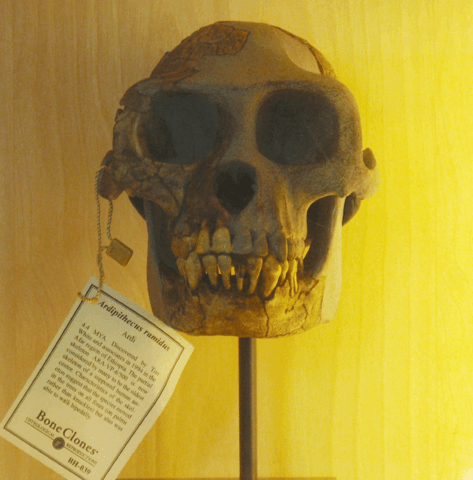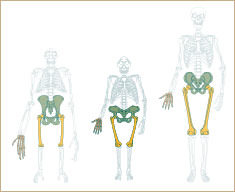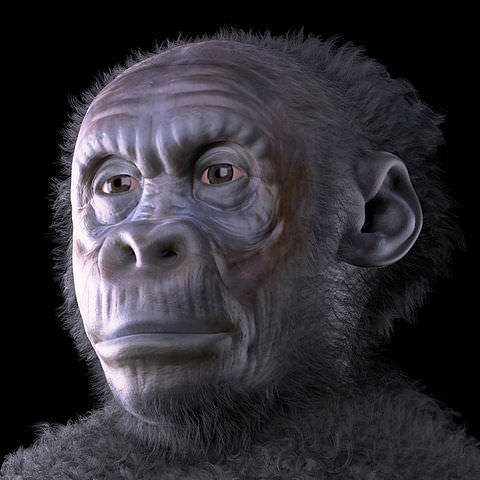7.4 Hominin早期演变
章节大纲
-
African Origins
::非洲起源Do the "people" in this painting represent our ancestors ? Based on evidence provided by hundred of , the answer is most likely yes. T he individuals in the picture — informally called australopithecines, would have lived in Africa between about 4.2 and 2.5 million years ago. Some of their descendants would evolve into members of our own genus , Homo. The australopithecines were the first known true hominins.
::这幅画中的“人”是否代表我们的祖先?根据100人提供的证据,答案很可能是肯定的。 照片中的个人 — — 非正式地被称为“大百科动物” — — 大约在420万到250万年前就在非洲生活了,他们的一些后代会演变成我们自己的人,同性恋。 青百种动物是第一个已知的真正人。What Are Hominins?
::什么是霍明因?Hominin is a term that refers to modern humans and their immediate ancestors. Any that evolved in the human lineage after it diverged from the chimpanzee lineage about six million years ago is called a hominin. Hominins include our own species Homo sapiens and other, now-extinct species of Homo. They also include several species in at least two extinct genera, named Australopithecus and Paranthropus, both of which are described below. The australopithecines pictured above are members of the genus Australopithecus. At least one species in this genus is presumed to have evolved into the Homo genus by about 2.5 million years ago. All the species in the Paranthropus genus, in contrast, went extinct about a million years later.
::霍明是现代人类及其直系祖先的名词。任何在六百万年前脱离黑猩猩系后在人类系中演变而成的物种,都称为荷明。Homminins包括我们自己的物种“同性人种”和其他现已灭绝的同性物种。它们还包括至少两个已灭绝的基因中的若干物种,即Australoptithecus和Parhoultous,这两个物种如下文所描述。上面所描绘的奥斯特罗皮西切斯系系是奥斯特罗皮科斯人种的成员。这个基因中至少有一种物种被认为在大约250万年前已经演变为同性基因。相比之下,Parhoulfus基因中的所有物种在大约100万年后都灭绝了。The main defining trait of all hominins is their bipedalism (walking on two legs). From the earliest australopithecines, this was the habitual means of . Bipedalism is reflected in the fossilized remains of these extinct hominins, and it no doubt played a major role in their evolution. Unlike modern humans, however, early hominins were still more ape-like above the neck. Relative to us, they had much smaller brains and relatively large molar teeth and jaws.
::所有荷明人的主要特征是两足两足的两足运动。从最早的青蒿素开始,这是惯用的手段。双足主义体现在这些灭绝的荷明人残骸的化石中,毫无疑问,它在其进化过程中发挥了主要作用。然而,与现代人类不同,早期的荷明在颈部上方还是更像青春。相对我们而言,他们的大脑小得多,牙齿和下巴也比较大。Proto-Hominins
::原主要质How did the hominins first arise? Recently, a number of fossils were discovered in Africa that shed light on their origins. These fossils represent early transitional forms between the chimpanzee and hominin lines. They are considered proto-hominins instead of hominins because of their transitional nature. They were not hominins themselves, but some of them no doubt gave rise to the earliest true hominins, the australopithecines. These proto-hominins lived between about seven million and 4.4 million years ago. Their fossils have been placed in three genera, the most recent of which was the genus Ardipithecus.
::何以出现?最近,在非洲发现了一些化石,这些化石揭示了它们的起源。这些化石代表了黑猩猩和荷米宁线之间的早期过渡形式。这些化石因其过渡性质而被视为原生的人类,而不是人类。它们本身不是人类,但其中有一些毫无疑问地产生了最早的原生物,即自食其果。这些原生物生活在大约700万至440万年前之间。它们的化石被放在三个基因组中,其中最近的一个是阿迪皮特库斯人。Ardipithecus lived from about 5.8 to 4.4 million years ago in East Africa, and is considered the most likely ancestor of the australopithecines. You can see a reconstructed skull of Ardipithecus . Its teeth appear to be transitional between those of chimpanzees and the earliest australopithecine species. Ardipithecus may represent the first step in the hominin lineage on the road to full bipedalism. Some features of its skeleton — such as the shape of its pelvis — are similar to later bipedal hominins, although the skeleton also retains traits of tree-climbing apes, such as a divergent big toe that allows the foot to be used for grasping. This should come as no surprise because Ardipithecus probably lived in forests.
::Ardipithecus从大约580万年前的东非到440万年前的东非,被认为是最有可能成为大象的祖先。你可以看到一个重建后的阿尔迪皮特克斯头骨。它的牙齿似乎是黑猩猩的牙齿和最早的大象的牙齿之间的过渡。阿迪皮特克斯可能是通向完全两足主义的道路上血印线的第一步。其骨骼的一些特征,例如骨盆的形状,类似于后来的两头大象,尽管骨骼还保留着树爬的猿的特征,例如一个不同的大尖尖,可以用来抓脚。这并不奇怪,因为Ardipithecus可能住在森林里。This skull of Ardipithecus is about 4.4 million years old. It was found in East Africa.
::Ardipithecus的头骨有440万年的历史,是在东非发现的。Australopithecines
::澳大药店The earliest known australopithecines had evolved by about 4.2 million years ago in East Africa. By three million years ago, they were common not only in East Africa, but in South Africa, as well. During this time period, the climate in Africa was becoming increasingly arid. Tropical forests were being replaced by open woodlands and savannas (dry grasslands). The australopithecines exploited these environmental changes in part by becoming more efficient as bipedalists.
::最早已知的亚松林在东非已经演化了大约420万年前。三百万年前,它们不仅在东非很常见,而且在南非也很常见。在此期间,非洲的气候越来越干旱。热带森林被开阔的林地和热带草原(干草地)所取代。 亚松林部分地利用了这些环境变化,成为了双足动物。Bipedalism in Australopithecines
::Australoptitheacines的双脚主义By three million years ago, some of t he australopithecines had become fully bipedal. They were probably almost as efficient at walking on two legs as modern humans are! This is apparent when you compare their skeletal features with those of modern humans and quadrupedal chimpanzees, as in the figure .
::三百万年前,一些大青蒿素已经完全两极分化了。 它们几乎能像现代人类一样精巧地双腿行走。 当你比较它们的骨骼特征和现代人类和四肢黑猩猩的骨骼特征时,这一点就很明显了,就像数字中的数字一样。-
Like modern humans, the legs of australopithecines were longer than their arms, and their feet had arches for better support of the body.
In contrast, in chimpanzees,
the arms are longer and the feet lack arches.
::与现代人类一样,青蒿素的双腿长于他们的手臂,他们的双脚有更好的支撑身体的拱门。 相反,在黑猩猩中,双臂长,脚缺拱门。 -
The australopithecine pelvis is short and wide, like that of modern humans. The chimpanzee pelvis, in contrast, is tall and narrow, which is more suited for quadrupedal
ism
.
::黑猩猩的骨盆和现代人类的骨盆一样短而宽。 相反,黑猩猩的骨盆又高又窄,更适合四重主义。 -
Like the human big toe, the australopithecine big toe is not divergent, whereas it is divergent in the more
arboreal
chimpanzee. A divergent big toe, which allows the feet to be used for grasping branches, is not well suited for long-distance walking.
::与人的大脚趾一样,大脚趾Australopithecine没有差异,而大脚趾在更偏僻的黑猩猩中则有差异。 不同的大脚趾允许用脚来抓树枝,但不适合长途行走。 -
The fingers of australopithecines are short and straight like human fingers.
Chimpanzees — who often climb trees — have longer, curved fingers.
::青蒿素的手指短短,直如人类手指,黑猩猩——经常爬树——的手指更长、更弯曲。
Chimpanzee (left), australopithecine (center), human (right)
::黑猩猩( 左) 、 丙烯菊酯( 中心 ) 、 人( 右)There are several reasons why being bipedal — especially in a warm, sunny savanna habitat — would be advantageous for australopithecines:
::双头动物——特别是在温暖、阳光明媚的热带热带草原生境中——对青蒿素具有优势的原因有几个:-
Being able to remain upright would make it easier to spot
food
resources and
predators
over tall grasses.
::如果能够保持正直,就更容易在高草上发现食物资源和掠食者。 -
Holding the body upright reduces sun exposure on the skin. It also reduces
absorption
of the sun's heat, and makes it easier for the body to release heat to the environment.
::直立地保持身体会减少皮肤的太阳照射,也会减少太阳热的吸收,使身体更容易向环境释放热量。 -
A biped can have a longer stride and travel farther than a quadruped. This would be a benefit particularly if food resources were widely scattered, requiring long-distance travel.
::双胞胎的足迹和旅行距离可以比四倍长。 特别是如果食物资源被广泛分散,需要长途旅行,那将是一个好处。 -
Bipedalism frees the hands to carry things, from food and tools to
infants
.
::从食物和工具到婴儿,两足主义让双手自由携带东西。
Other Australopithecine Traits
::其它澳洲迷幻药片Whereas the body of an australopithecine was quite human-like, its head was not. Compared with modern Homo sapiens , australopithecines had a much smaller brain . The modern human skull is generally widest in the region of the temples because of our big brain, but for australopithecines, the widest point was in the region of the cheeks. The australopithecine face was large, as were the back teeth, which had thick enamel. Relative to the big back teeth, the front teeth were fairly small, although some of the earlier australopithecines still had large canine teeth (which is an ape-like trait).
::与现代的智人相比,青蒿素是一种小得多的大脑。 现代的人类头骨一般在寺庙区域最宽,因为我们的大脑很大,但对于青蒿素来说,最宽的点是在脸颊区域。 青蒿素面孔很大,后牙和后牙一样厚。 相对于大后牙,前牙也很小,尽管早期的青蒿素牙齿中有些还长着大犬牙(类似大犬牙的特征 ) 。Australopithecine Species
::澳大洛皮类动物物种New australopithecine fossils are being found all the time, so we don't know for sure how many species of this genus existed. Based on currently available evidence, there are at least three species in the genus Australopithecus widely agreed upon by paleontologists : A. anamensis, A. afarensis, and A. africanus.
::古生物学家们广泛认同的奥斯特洛皮西提库斯(A. A. A. A. A. A. A. A. A. A. A. A. A. A. A. Africanus)至少有三种物种。Australopithecus anamensis
::Austraoptithecus 麻醉剂A. anamensis is thought to be the oldest species in the genus Australopithecus , living from approximately 4.2 to 3.9 million years ago in East Africa. The fossils for this species are few in number and consist mainly of fragments, so not a lot is known about it. The fossils have been found in what would have been wooded areas around lakes. The diet of A. anamensis probably consisted mainly of fruits and nuts. Based on its limb , it appears that A. anamensis was bipedal, but it may have also been good at climbing trees. Its canine teeth were large, and its teeth were arranged in the jaws in a rectangular shape. Apes also have a rectangular tooth arrangement, whereas the tooth arrangement in humans is shaped like a parabola (or arc).
::A. Aamensics被认为是Australopithecus中最古老的物种,大约在420万年前生活在东非的Australopithecus,这种物种的化石数量很少,主要由碎片组成,因此对此了解不多。这些化石是在湖周围本可伐木的地区发现的。A. anamensis的饮食可能主要由水果和坚果组成。根据它的四肢,A. anamensis似乎是双向双向的,但也可能是爬树的好东西。它的犬牙很大,牙齿在下巴上以矩形形状排列。人猿也有一个矩形牙齿安排,而人的牙齿安排则像一个抛角(或弧)形状。Australopithecus afarensis
::法尔西的奥斯拉普提斯库斯A. afarensis lived somewhat more recently than A. anamensis. I ts fossils indicate a time span of about 3.7 to three million years ago, and all of them come from East Africa. The species is represented by one of the most complete fossilized skeletons of any australopithecine. This skeleton, which was named "Lucy" by the researchers who discovered it, is nearly 40 percent complete. You can see models of Lucy's fossilized bones in the photo . Lucy and other A. afarensis individuals still had some ape-like features of the body, including legs that were a little shorter and fingers that were a little longer and more curved than those of modern humans. A. afarensis was bipedal, but was probably still well suited for climbing trees. The canine teeth of A. afarensis were also relatively large.
::远洋人比A. A. A. A. 远洋人比A. A. A. 远洋人活得更近一些。它的化石表明,时间范围大约在37万到300万年前,它们都来自东非。这些物种代表着任何单方龙的最完整的化石骨骼之一。这个由发现它的研究人员命名为“卢西”的骨骼几乎完成了40%。你可以在照片中看到露西化石骨骼的模型。露西和其他A. 远洋人仍然有一些类似身体的特征,包括比现代人类短一点的腿和手指短一点,手指比现代人长一点,更弯。A. 远洋人是两栖的,但很可能仍然适合爬树。A. 远洋人的犬牙也相对较大。A noted feature of this species of Australopithecus is its gracile body build. It was short and slender with a small bone structure. Adult males were about 151 cm (4 ft 6 in) tall and weighed about 42 kg (92 lb), and adult females were about 105 cm (3 ft 5 in) tall and weighed about 29 kg (64 lb). Both males and females were small, but there was obviously a considerable amount of sexual dimorphism in body size.
::Australopithecus这种物种的一个显著特征是其面状体结构,体积短、细,骨骼结构小,成年男性约151厘米(4英尺6)高,体重约42公斤(92磅b),成年女性约105厘米(3英尺5)高,体重约29公斤(64磅b),男性和女性都小,但身体体积明显存在相当大的性畸形。This photo shows the fossilized remains of the A. afarensis individual named Lucy in their correct anatomical positions.
::这张照片展示了A. 远方人 名叫Lucy的化石化遗骸 在正确的解剖姿势上Australopithecus africanus
::非洲印第安人协会A. africanus lived from about 3.3 to 2.5 million years ago in East Africa and from about three million to 2.5 million years ago in South Africa. y ou can see a reconstruction of the head of A. africanus based on fossils from South Africa. L ike A. afarensis , A. africanus was gracile in body build, but A. Africanus had considerably less sexual dimorphism in body size. In this and certain other ways, A. africanus was less ape-like and more human-like than earlier australopithecines. This is true of its teeth. Compared with the dentition (arrangement of the teeth) of A. afarensis , the A. africanus canines are smaller, and the front teeth a little larger relative to the molars. These changes in dentition may mean that A. africanus had a different diet than earlier australopithecines.
::A. A. A. A. A. Africanus在身体结构上是灰色的,但A. Africanus在身体体积上的性畸变要小得多。A. Africanus在这种方式和其他方式中,与早先的A. A. A. A. Africans 相比,与A. A. Africans 的牙齿相比,A. A. A. Africans 罐头(牙齿的排列)较小,前牙与摩尔相比要小一些。这些标记的变化可能意味着A. A. A. Africans的饮食与以前的A. A. A. A. A. Africfricans 罐子不同。A. A. A. Africannus.Scientists have analyzed the microscopic wear patterns on the teeth of A. africanus, revealing that their diet consisted of relatively soft foods, which means they had probably adapted to an omnivorous diet. They may have eaten fruits and other soft plant parts, as well as foods, such as meat. A. africanus may have scavenged leftovers from the kills of large predators, such as lions. They may also have hunted small mammals , captured and grubs, and gathered eggs .
::科学家们分析了A. Africanus牙齿上的微缩观察式磨损模式,揭示了他们的饮食由相对软的食品组成,这意味着他们可能已经适应了一种全食饮食。 他们可能吃了水果和其他软植物部件,以及食物,如肉类。 A. Africanus可能把狮子等大型掠食者所杀的残渣挖出来。 他们也可能捕猎了小哺乳动物、捕捉了它们,收集了它们的食物,并收集了鸡蛋。Based on fossils for this extinct species, this is how A. africanus may have appeared.
::根据这种灭绝物种的化石来看, A. Africanus可能就是这样出现的。A. africanus has not shown up in the fossil records for about 2.5 million years, which is when two other lineages of hominins appeared in East Africa, both presumably evolving sometime earlier from australopithecines. One was the Homo lineage, which would eventually lead to Homo sapiens . The earliest species in the Homo genus, H. habilis , probably evolved from A. africanus . You can read about what happened in the Homo lineage in the concept Evolution of the Genus Homo. The other lineage that appeared at 2.5 million years ago was the Paranthropus genus, which you can read about next.
::一个非洲人大约250万年来没有出现在化石记录中,也就是在东非出现了另外两条人类系,两者可能早些时候都从大象中演变而来,其中一条是同族系,最终将引致同族动物。H. habilis的最早物种可能从A. Africannus演变而来。你可以读到Genus同族进化概念中的同族系发生的情况。另外一条在250万年前出现的情况是Parhountous genus,你可以读到下一段。The Genus Paranthropus
::热纳斯·帕罗人类Fossils that have been classified in the genus Paranthropus have been found in East Africa, covering the period 2.5 to 1.4 million years ago. They have also been found in South Africa, covering the period two to 1.4 million years ago. The Paranthropus fossils have been placed in three different species.
::被归类在Parholidus基因中的化石在东非发现,覆盖时间为250万至140万年前,在南非也发现,覆盖时间为200万至140万年前,Parholidus化石被置于三种不同的物种中。Compared with the gracile bodies of the australopithecines, Paranthropus individuals had more robust bodies. They had thicker, heavier bones, and they were also more muscular. In addition, they had very large, strong jaws and extremely large molars with especially thick enamel. The males had a ridge of bone on top of the head (called a sagittal crest) where the powerful jaw attached to the skull. This is also a feature found in apes, such as gorillas.
::与大类动物的酸性动物相比,Parhoultous人的身体更健壮,他们的骨头更厚,更重,肌肉也更强。此外,他们的下巴非常大,牙齿和极大的摩尔,特别厚。雄性雄性雄性雄性雄性大鼠头顶有一块骨头的脊骨(称为长颈骨 ) , 头部的下巴与头骨相连。这也是猩猩等猿类体内发现的一个特征。The more ape-like features of the head provide evidence that Par anthropus had diverged from the evolutionary line that would lead to humans. The earliest members of the genus Homo ( H. habilis ) lived in East Africa at the same time as Paranthropus, offering additional evidence that Paranthropus species were not our ancestors. All three Paranthropus species went extinct by 1.4 million years ago. They left no descendants, and were an evolutionary dead end.
::最像猿类的人头特征证明,帕罗努斯已经脱离了导致人类的进化线。 最早的同性人(H. habilis)与帕罗努斯同时生活在东非,进一步证明帕罗图斯物种不是我们的祖先。 这三个帕罗图斯物种在140万年前都灭绝了,他们没有留下后代,而是进化的死胡同。Summary
::摘要-
Hominin is a term that refers to modern humans and their immediate ancestors. Any species that evolved in the human lineage after it diverged from the chimpanzee lineage about six million years ago is called a hominin. Hominins include
modern
Homo sapiens,
extinct species of the genus
Homo,
and species in the extinct genera
Australopithecus
and
Paranthropus.
The main defining trait of all hominins is bipedalism.
::霍明是现代人类及其直系祖先的名词。 人类系系中在与大约六百万年前的黑猩猩系脱节后演变而来的任何物种都被称为“荷明 ” 。 霍明包括现代智人、同族灭绝的物种以及灭绝的奥斯特罗皮提科斯和帕罗努克斯基因中的物种。 所有人类系的主要特征是双足主义。 -
The genus
Ardipithecus
, which lived in East Africa from about 5.8 to 4.4 million years ago, is the most likely ancestor of the hominins. It had taken the first step on the road to bipedalism, while retaining many ape-like traits.
::大约在580万到440万年前居住在东非的阿尔迪皮特库斯(genus Ardipithecus)是最有可能成为人类的祖先的。 它迈出了迈向两足主义的第一步,同时保留了许多类人猿的特征。 -
The earliest known true hominins belonged to the genus
Australopithecus.
Commonly called australopithecines, they had evolved in East Africa by 4.2 million years ago and were also present in South Africa by three million years ago. By then, they were almost as fully bipedal as modern humans, but they continued to have ape-like traits above the neck.
::最早的已知真人猿属于奥斯特洛皮提克斯人。 通常被称为阿司罗皮西喀斯人,它们于420万年前在东非演变成420万年前,在南非也存在300万年前。 那时,它们几乎和现代人类一样完全两极分化,但它们在脖子上仍然有着像猿一样的特征。 -
When the australopithecines were evolving, the climate in Africa was becoming drier and forests were being replaced by savannas. These environmental changes may have made bipedalism more advantageous.
::这些环境变化可能使双双脚主义变得更为有利。 亚马逊和亚马逊的热带热带热带热带热带热带热带热带热带热带热带热带雨林正在形成,非洲气候正在变得干燥,森林正在被热带热带草原所取代。 这些环境变化可能使得双脚主义变得更为有利。 -
Species in the genus
Australopitihecus
included:
A. anamensis
(East Africa, 4.2-3.9 million years ago);
A. afarensis
(East Africa, 3.7-three million years ago); and
A. africanus
(East Africa, 3.3-2.5 million years ago, and South Africa, three-2.5 million years ago).
::A. A. Afarensis(东非,420万至390万年前);A. Afarensis(东非,370万至3百万年前);A. Africanus(东非,330万至250万年前;南非,3至250万年前)。 -
About 2.5 million years ago, australopithecines disappear from the fossil record, but at least one species of
Australopithecus
(probably
A. africanus
) evolved into the earliest species of
Homo
(
H. habilis
) in East Africa. Around the same time, some other species of
Australopithecus
evolved into the genus
Paranthropus,
which went extinct by 1.4 million years ago, without leaving any descendants.
::大约250万年前,古老的亚松森从化石记录中消失,但至少一种亚松森(可能是A. Africanus)物种(可能是A. Africanus)在东非演变成最早的同性(H. H. Habilis)物种。 大约与此同时,其他其他的亚松森物种也演变成Parhountous 人,该物种在140万年前灭绝,没有留下任何后代。
Review
::回顾1. What are hominins? What is their main defining trait?
::1. 什么是人马?他们的主要特征是什么?2. Describe the genus Ardipithecus and its place in hominin evolution.
::2. 描述阿迪皮特库斯人及其在荷明进化中的位置。3. Identify the skeletal features of the australopithecines that are associated with bipedalism.
::3. 查明与双足肢主义有关的亚甲二联苯醚的骨骼特征。4. Explain why bipedalism would have been advantageous when the australopithecines were evolving.
::4. 解释为什么在亚甲二联苯菊酯不断演变时,二联足主义会有利。5. List the three australopithecine species, along with the time spans and locations of their fossils.
::5. 列出三种亚甲二醇类以及其化石的时间跨度和位置。6. Which australopithecine species most likely evolved into the earliest species of Homo in East Africa?
::6. 哪种亚甲二醇类最有可能演变成东非最早的同性物种?7. How did australopithecines differ from Homo?
::7. 青蒿素与同性人有何不同?8. Compare and contrast the genera Australopithecus and Paranthropus.
::8. 比较和对比Australopithecus和Parhountous的基因。9. What evidence suggests that Paranthropus was not part of the hominin lineage that led to Homo?
::9. 有何种证据表明Parholidus不是导致同性恋的荷明系的一部分?10. Which of the following has/had a divergent big toe?
::10. 下列哪一种具有或具有不同的大脚趾?a. A. anamensis
::a. A. 麻醉剂b. Ardipithecus
::b. 阿尔迪皮斯c. chimpanzees
::c. 黑猩猩d. B and C
::d. B和C11. Which probably has/had the straightest fingers?
::11. 哪个手指可能最直?a. chimpanzees
::a. 黑猩猩b. A. afarensis
::b. A. 远 地c. Homo sapiens
::c. 智人d. proto-hominins
::d. 原人种12. The earliest species in the Homo genus was Homo ________ .
::12. 同性恋人中最早的物种是同性恋 。13. True or False: The skeleton known as “Lucy” was the first human.
::13. 真实或假:被称为 " 卢西 " 的骨架是第一个人。14. True or False: Later species of Australopithecus were generally less sexually dimorphic than earlier species.
::14. 真实或假的:澳大罗普西提科斯的后代物种与先前的物种相比,一般较少具有性畸形性。Explore More
::探索更多Toes are something we rarely think about, but why do we have them? Find out more here:
::脚趾是我们很少想到的 但是为什么我们有脚趾呢?The discovery of Lucy was pivotal to our understanding of human evolution . L earn more here:
::露西的发现对于我们了解人类进化过程至关重要。 -
Like modern humans, the legs of australopithecines were longer than their arms, and their feet had arches for better support of the body.
In contrast, in chimpanzees,
the arms are longer and the feet lack arches.




